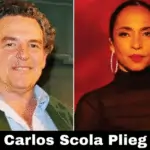Introduction
Start with the name. Most of the more reliable listings are using the name “Carlos Scola Pliego.” That form appears online under what is known as the “Plieg,” and traces to the same individual. If you are looking, bear in mind the two types, but use Pliego as the formal reference spelling.
In the 1980s, he did mostly crew and assistant-director work in Spanish and European film and TV. These are the foundational pieces of his public record. He later resurfaces as a credit in the feature Goal II: Living the Dream in 2007. In addition to film sets, he is also the Spanish translator of Matt Cohen’s novel El médico de Toledo. These things are distinctive, cross-referencable in catalogs, filmographies, and Production Notes with names, roles, and years.
Quick bio outline
- Nationality: Spanish
- Industry lanes: film and television crews, assistant direction, later dialogue or language support credit, plus published book translation
- Public attention driver: marriage to the singer Sade in 1989, divorce in 1995
- Name confusion to avoid: do not mix him up with Ettore Scola, an Italian director from a different generation
This is not a celebrity profile built on rumors. It is a summary of credits and dates that appear in sources that keep real metadata, such as job titles, roles, and ISBNs.
Early film work
Reports from the early eighties feature him in jobs like script supervision, assistant direction, and other back-of-the-camera roles in Spain. These are the types of credits rarely found at the tip of a headline, but that are important to have if you want a clearer perspective of how crews were manned in that era on Spanish and European sets.
His name is often associated with a handful of titles from the late 1980s. There are documentary and feature references, dating from about 1988 to 1989. Consider those as a path in a working crew member’s life. The scheme is logical: begin in lesser fields, graduate to assistant directing gigs, toss in some international work with the right production lands in Spain or draws upon Spanish crews.
The Sade timeline, kept simple
Two dates pin the personal narrative. Married to Sade in 1989. Divorce in 1995. This linkage is the route through which many readers come to his name. Fine, but don’t confuse it with work experience. Another common point I would like to note: kids. The father of Sade’s child — who was born in 1996 — was from the more recent marriage to Carlos Scola Plieg.
For Sade’s Promise album cycle in 1985, Spanish press retrospectives and production notes have long claimed he was involved in video productions from that era, in an assistant director capacity. It also helps clarify the circumstances in which a Spanish crew member met and married a UK-based artist.
Translation work
Search through Spanish book listings for El médico de Toledo and you’ll find Carlos Scola Pliego listed as the translator. That credit has appeared in various Spanish editions over the years. The translator field sits next to author, title, and ISBN in most publisher entries. That is handy because it establishes participation other than film, with dates and book-trade metadata that rely on secondhand gossip.
The why: In a world where someone has been persona non grata, you want records that have accountability. Translation credits do that. There is no middle ground for a name — it either appears on the title page or it does not, and it sticks through editions and reprints.
A later screen credit
In 2007, his name reappeared in mainstream film credits for Goal II: Living the Dream, also in a dialogue or language support role. So for anyone keeping a timeline, this, in English, is a later touchstone post-’80s cluster-fuck of credits.
Why the name keeps getting searched
When people read about Sade’s life, they often type his name. Some discover him simply by perusing crew rosters on 80s-era Euro films. Another smaller group follows his name by way of book listings in Spain. And that cocktail forms a diffused digital footprint. To maintain simplicity, the best way to do so is to classify based on your line of work: film crew credit, translation credit, and personal chronology.
Common mistakes and how to avoid them
- Mixing him up with Ettore Scola
Different country, different era, different body of work. Only the surname overlaps. If a page starts pulling in Italian films from the 1970s and calling them his, you can stop reading. - Dropping “Pliego”
The clipped “Plieg” form appears often. It is the same person, but formal credits use “Pliego.” If you file a profile or a citation, use the full version. - Treating speculation as fact
You will see pages that add unverified personal details. If there is no production document, publisher listing, or official bio backing the claim, set it aside.
How to check information without getting stuck
You do not need links to run a clean check. Use structured sources with names and fields you can sort.
- For marriage and divorce dates, look for official artist biographies and discography-adjacent timelines. Those are the places that list personal milestones with specific years.
- For film credits, rely on databases that separate roles by department and year. Search the title, open the full credit list, then look for assistant director, script supervisor, or similar crew slots.
- For the book translation, go straight to Spanish publisher catalogs and retailer details. You want edition year, ISBN, and the “traductor” field. When the same name appears across editions, you have a stable record.
Short timeline you can reference
- Late 1970s to early 1980s: crew roles in Spain, including script supervision and assistant direction.
- Mid 1980s: assistant director work on international productions that engaged Spanish crews, plus involvement around Sade’s video shoots from the 1985 cycle.
- 1988 to 1989: documentary and feature activity attached to his name in databases and Spanish sources.
- 1989: marriage to Sade.
- 1995: divorce.
- 2006 onward: translator credit on Spanish editions of El médico de Toledo, including later reissues.
- 2007: credit on Goal II: Living the Dream.
This outline keeps the order clear without inflating what is known.
Practical tips if you are writing an article about him
- Use both spellings when you search, but publish with “Carlos Scola Pliego.”
- When you list film work, do not stop at the title. Add the exact role and year. That prevents accidental credit inflation.
- Keep the Sade timeline to two dates unless the story requires more detail. The personal link explains why the name surfaces, but it is not the whole story.
- If you mention the book translation, include the title in Spanish, the original English title in brackets if needed, the author, and the translator credit. If you have the ISBN, note it.
- Never merge his record with Ettore Scola. If an item looks Italian and from a different decade, it probably is.
Why this profile matters
Names are searched by people for various reasons. Biographical clarity is one. Another is the cataloging of film and publishing history. Crew members often are erased with fans and press choosing to focus on directors and stars. This matters not just for researchers and archivists, but for anyone trying to piece together how a production was brought to life: as Max on This American Life put it, “Keeping assistant director and crew credits accurate matters. A similar reason applies to translation credit. It records work done in the public space, with metadata that can be verified in the future.
FAQs
Who is Carlos Scola Plieg, also listed as Carlos Scola Pliego
A Spanish film professional whose public record shows crew and assistant director roles in the 1980s, a later credit connected to Goal II: Living the Dream in 2007, and a translator credit on Spanish editions of El médico de Toledo. He was married to Sade from 1989 to 1995.
Is “Plieg” a different person
No. It is a shortened version that appears online. Formal credits use “Pliego.”
Did he and Sade have children together
No. Sade’s child, born in 1996, is from a later relationship.
What is the most reliable non-film credit
The translator credit on El médico de Toledo. Spanish editions list the translator field, which confirms his role across different years.
Why is information after 2007 sparse
Because he keeps a low public profile and because assistant director or language roles do not receive the same coverage as directing or acting. Film databases list what they have. If there were later public roles, they would appear in those lists.
How can I avoid pulling in the wrong credits
Filter by country, job title, and year. If a title belongs to an Italian director from the 1970s or 1980s, it is not his. If a page lists him as director for major international hits without supporting crew records, be careful.
Conclusion
There are three obvious entries on the public record for Carlos Scola Plieg, perhaps better spelled Carlos Scola Pliego. Initially, in the 1980s, I worked on Spanish and European films mostly as an assistant director and crew. Second, in the Sade-connected personal chronology, married in 1989, divorced in 1995. Third, two easily confirmable later anchors: a 2007 movie credit related to Goal II: Living the Dream and a translation credit on the Spanish editions of El médico de Toledo. So that when you publish, the name is spelled the same way, when you list the job description exactly the same, and now don’t interleave the filmography by Ettore Scola.

